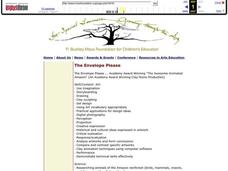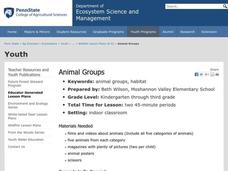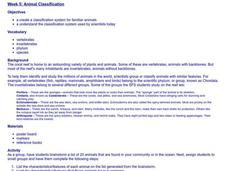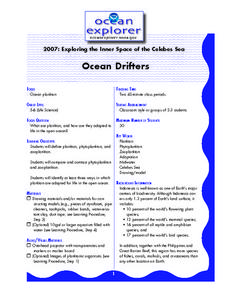Curated OER
The Envelope Please
Students research an animal of the rainforest. They create a computerized claymation to present their research.
Curated OER
Layers of the Rainforest
What a great way to discuss the rainforest! Learners discuss the importance of adaptation in the environment and how it is linked to survival. They use critical thinking and inference skills to place animals and insects in the different...
Curated OER
Heating and Cooling a Really Large Lizard
Remind your middle school scientists how fox ear size varies depending on the climate they live in; large ears allow heat loss while small ears keep heat in. Discuss how a cold-blooded animal might try to regulate body temperature. Then...
Curated OER
Animals Project for German Students
Who doesn't love animals? Young learners will be excited to develop their vocabulary and categorize animals into different lists. This includes a fun extension activity that encourages the older learners to create a PowerPoint...
Indian Land Tenure Foundation
Relationships to Places
Young historians take a look at how the Indian tribes of California promoted a mindful relationship between people and the land. They begin to understand how the Indians were champions of conservation, and at preserving the natural...
ARKive
Adaptations to Arid Habitats
How do plants and animals survive in habitats with very little water? Explore arid ecosystems and the way their inhabitants have adapted with a instructional activity and science experiment. After kids listen to a presentation about...
Alliance Theater
The Jungle Book Post-Show STEAM Lesson
An ecosystem is really just the flow of energy through many different living organisms. A study of Rudyard Kipling's The Jungle Book leads to an environmental science activity in which learners study how various factors can affect...
Curated OER
Which Herp Is Which?
Students research different kinds of herps. The teacher gives the student a particular herp and the student writes a postcard (as the herp) to an in-class penpal, giving hints about the herp, but not identifying itself.
Curated OER
Food Web
Young scholars are able to define food web, and identify the interdependence of organisms within a system. They are able to describe how natural events and human activities can impact a food web.
Curated OER
Animal Groups
Learners explore animal groups. For this animal science lesson, students use pictures from magazines and classify the animals into five categories. Learners share why they categorized the animals the way they did.
Curated OER
What's A Mammal?
Students examine mammals understanding what a mammal is and reviewing the eleven mammal groups. In this science lesson, students play a game known as Mystery Mammal Game. Yet, first students research about the mammal and then give...
Curated OER
Desert Animals
Young scholars survive within an ecosystem, an animal must be physically and behaviorally adapted to the conditions of its environment.
Curated OER
Animal Classification
Students list characteristics and features of animals found in their community. They then group the animals according to how they are similar and different and create names for each group. They then create a chart of their...
Curated OER
Comparing Two Turtles
Students compare and contrast the various observable features of two different turtles. in groups, they complete a visual analysis of the sea turtle and tortoise. Using their observations, they complete Venn Diagram of the observable...
Curated OER
Quiz
In this quiz worksheet, students, after researching and discussing different types of world-wide animals, determine the answers to ten key true and false questions.
Curated OER
Great Blobs of Jelly!
Students explain how zoo-plankton have an impact on the global process. In this ocean zoo-plankton lesson students calculate carbon flux and plankton densities.
Curated OER
Ocean Drifters
Students define terms, and identify three ways in which plankton are adapted for life in the open ocean. In this ocean drift lesson students design a planktonic organism.
Curated OER
Do You Have the Key?
Students practice using a dichotomous key. In this classification instructional activity, students read an article about scientific exploration and identification of new species. They use a dichotomous key to identify objects and create...
Curated OER
Outta Gas
High schoolers explore practical problems that are related to scuba diving. In this oxygen lesson students complete a lab activity.
Curated OER
Let's Get Specific
High schoolers explore how different species thrive. In this speciation lesson students research and complete a lab activity.
Curated OER
Biomes: Adapting To Deserts & Other Ecosystems
Students examine how animals must be adapted to the conditions of its environment to survive. In this biomes lesson students research desert adaptations then discuss how these animals have survived.
Curated OER
An Imaginary Creature And Then Using Describing And Action Words for a Creative Writing Exercise
You have to collect lots of materials (boxes, bags, toilet paper rolls, etc.) for this lesson to work successfully. After modeling how to create an imaginary creature out of the collection of recycled materials, let your class search...
Curated OER
Prairie Mural Project
Seventh graders construct a large mural of a praire showing plants, and animals that would live there.
Curated OER
Animal-mania
Young scholars explore the concept of scientific classification systems using a guided Internet research activity. They answer specific questions on the classification of animals by exploring a different Internet link for each question.
Other popular searches
- Amphibians and Reptiles
- Amphibians Reptiles
- Amphibians and Reptiles K 2
- Amphibians and Reptiles K
- Reptiles Amphibians Fish
- Compare Reptiles Amphibians
- Amphibians and Reptiles Prek
- Reptiles Amphibians Birds
- Amphibians and Reptiles Unit
- Amphibians and Reptiles Perk
- Amphibians and Reptiles 3 5
- Reptiles Amphibians Anatomy

























